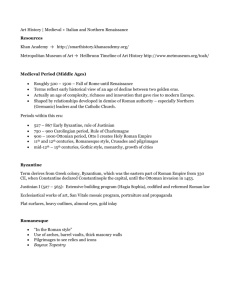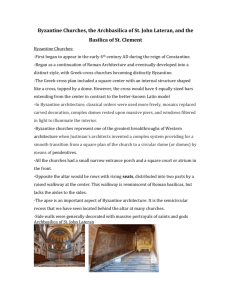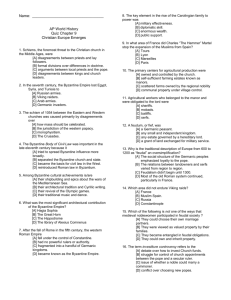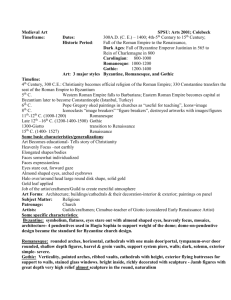Click here for
advertisement
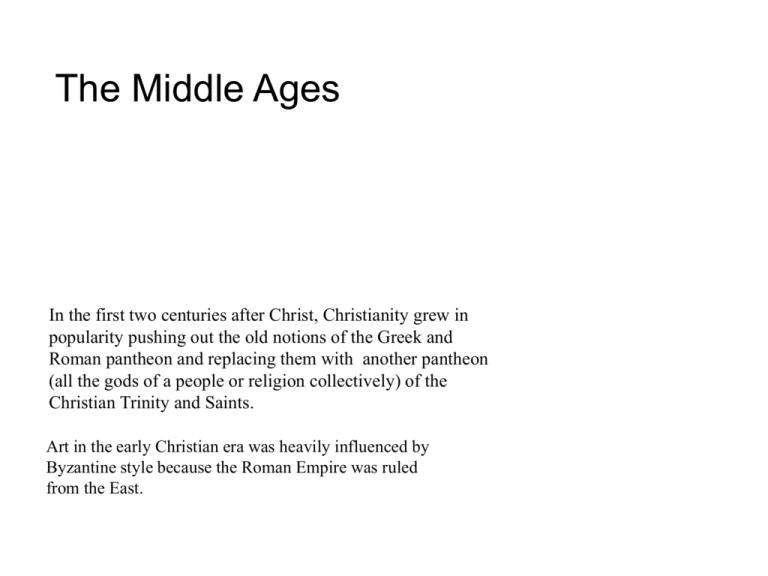
The Middle Ages In the first two centuries after Christ, Christianity grew in popularity pushing out the old notions of the Greek and Roman pantheon and replacing them with another pantheon (all the gods of a people or religion collectively) of the Christian Trinity and Saints. Art in the early Christian era was heavily influenced by Byzantine style because the Roman Empire was ruled from the East. Map of the Byzantine Empire Head of Constantine Rome, ca. 325 Marble H. 37 1/2 in. (95.3 cm) Byzantium Byzantine refers to eastern Mediterranean art from AD 330, when Constantine transferred the seat of the Roman Empire to Byzantium (later called Constantinople) until the city’s fall to the Turks in 1453. The focus is on human figures, whose identities reveal three main elements in the formation of the Byzantine empire. Most prominent are the holy figures of the Christian faith--Christ, the Virgin Mary, the saints, and the apostles. Bishops and angels often are portrayed in their company. Central to the political structure was the emperor, who was believed to be divinely sanctioned by God. Art played a vital role in visualizing his powers. Images of cherubs, mythological heroes, gods and goddesses, and personifications of virtues are reflections of the continuing influence of Byzantium's classical heritage. Byzantine-Central-dome church Hagia Sophia 532-37 AD “holy wisdom” Emperor Justinian assigned the task of building the structure to two mathemeticians, Anthemius of Tralles and Isidorus of Miletus. He wanted to build a church as grand as his empire in the great city of Constantinople, the greatest city in the world for 400 years. The church measures 77 x 79 m. and the impressive huge dome soaring 62 m. above the floor has a diameter of about 33 m. Diagram of domes on cylinder, squinch, pendentive The dome of the Hagia Sophia (Istanbul) undergoing restoration. Apse Portrait of Saint John Chrysostom of Antioch (Hagios Ioannis Chrysostomo) Icons Gloomy images, but absolutely necessary when discussing Byzantine art. Often images of tortured martyrs, were typically rigid, frontal poses with large staring eyes. These small wooden paintings were believed to possess supernatural powers. Saint Demetrios is believed to have been a deacon who was killed in Serbia in the late third century while preaching the Christian gospel. His legend grew in the East. During the Middle Byzantine period he began to be represented in military dress, literally as a soldier of Christ. He is known as the patron saint of both the city of Thessalonike, Greece, and the church of Constantinople. Icon with Saint Demetrios Byzantine, second half of the 10th century Ivory 7 3/4 x 4 3/4 (19.6 x 12.2 cm) The Metropolitan Museum of Art, Byzantine Mosaics Unlike the Romans who used opaque marble cubes, Byzantine artists used reflected glass cubes to create mosaics that sparkled. Their surface was uneven to reflect even more light. Byzantine mosaics are found on walls and ceilings-especially on church domes and apse. Romans used mosaic mainly in private homes. Subjects were religious, and larger cubes created a more stylized design, as opposed to the Romans who used minute pieces to create a more realistic image. The Battle of Issus, Pompeii c.80 BCE The Battle of Issus, Pompeii c.80 BCE Justinian and Attendants c.547 San Vitale, Ravenna Miracle of Loaves and Fishes Location: Sant' Apollinare Nuovo c.540 Christ between two angels, St. Vitalis, Bishop Ecclesius Location: San Vitale c.540 Theodora and attendants Location: San Vitale c.540 Romanesque 1050-1200 With the Roman Catholic faith firmly established, a wave of church construction occurred. Builders borrowed elements from Roman architecture, such as rounded arches and columns, giving rise to the term Romanesque. Yet because Roman building were timber roofed and prone to fire, medieval artisans began to roof churches with stone vaulting. In this system, barrel vaults resting on piers could span large openings. Pilgrimages were in vogue at the time, so church architecture took into account the hordes of tourists visiting the shrines of sacred bones, garments and splinters of the true cross brought back by the crusaders. Reliquaries held these sacred artifacts. St. Sernin Toulouse France c.1080-1120 The church of St. Sernin at Toulouse (c. 1075-1120) is one of the best-preserved examples of the pilgrimage plan churches. • the nave (the highest part of the roof) surrounded by the aisles and crossed by the transept • the crossing, surmounted by a tall tower • the apse, (the semicircular or polygonal termination to the choir or aisles of a church) with the ambulatory providing a passage around the monks' area for the pilgrims • the chapels off the apse and transepts, where relics were often on view for for the pilgrims Floorplan of St. Sernin Toulouse France c.1080-1120 The nave of St. Sernin showing barrel vaults Diagram of barrel (or groin)vaults example of reliquary The Last Judgement from Autun Cathedral c.1130-1135 (Burgundy) Realism yields to moralism. Bodies, distorted to fit the masonry niche, were elongated with expressions of intense emotion. Suicide of Judas 1120-30 Stone Cathedral of Lazare, Autun Saint- Dream of the Magi 1120-30 Stone Cathedral of Saint-Lazare, Autun Illuminated manuscripts Made from vellum (calfskin) or parchment (lambskin) manuscripts were considered sacred objects containing the word of God. Covers were made of gold and studded with precious stones. Until printing was developed in the fifteenth century, these manuscripts were the only form in existence, preserving not only religious teachings, but also classical literature. Book of Kells Illuminated gospel produced by Irish monks. (760-820) Gothic Art 1200-1500 Height and Light The pinnacle of Middle ages artistic achievement was the Gothic Cathedral (“stone bibles”). Medieval builders created intricate structures with soaring interiors unprecedented in the world of architecture. Chartres Cathedral, France 1300 Communal devotion to the buildings was so intense that everyone participated in construction. Lords and Ladies in worshipful silence worked alongside buthchers and masons. Buildings were so elaborate that costruction took ages, sometimes centuries, which explains why some seem a hodge-podge of successive styles. Floor plan of Chartres Cathedral Two engineering breakthroughs: ribbed vaults and external supports called flying buttresses, allowed builders to forgo solid walls with small windows for skeletal walls with huge stained glass windows flooding the interior with light. Ribbed vault Apse Buttresses South Flying Buttresses North Portal Nave The windows at Chartres measure over 25,000’ in total area. Illustrating the bible, these windows are like a giant illuminated manusscript. Rose Window Samaritan Glass Zodiac window Tapestry Weavers in the middle ages created highly refined tapestries minutely detailed with scenes of contempoary life. Large wool and silk hangings used to cut drafts , decorated stone walls in chateus and churches. Huge scale paintings were placed behind the warp of a loom in order to imitate the design in cloth. The Unicorn in captivity c.1500 The Lady and the Unicorn "To My One Desire" Flanders ca:~1510


